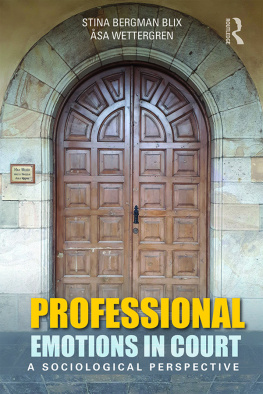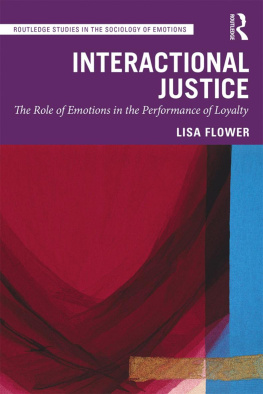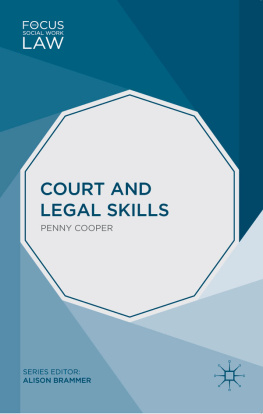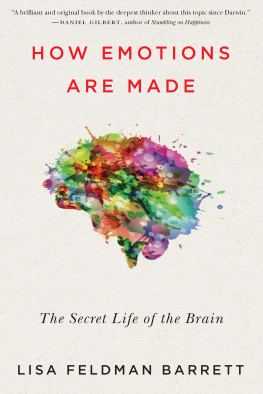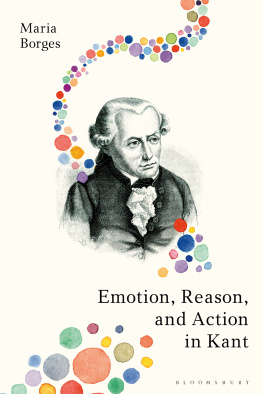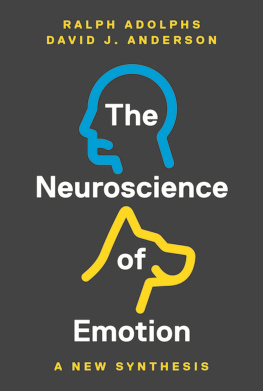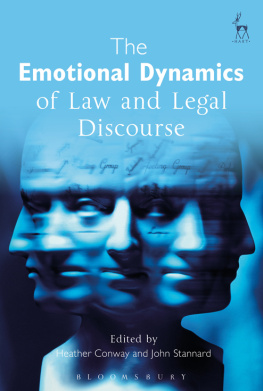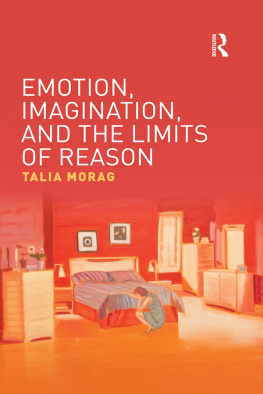Professional Emotions in Court
Professional Emotions in Court examines the paramount role of emotions in the legal professions and in the functioning of the democratic judicial system. Based on extensive interview and observation data in Sweden, the authors highlight the silenced background emotions and the tacitly habituated emotion management in the daily work at courts and prosecution offices. Following participants backstage whether at the office or at lunch in order to observe preparations for and reflections on the performance in court itself, this book sheds light on the emotionality of courtroom interactions, such as professional collaboration, negotiations, and challenges, with the analysis of micro-interactions being situated in the broader structural regime of the legal system the emotive-cognitive judicial frame throughout.
A demonstration of the false dichotomy between emotion and reason that lies behind the assumption of a judicial system that operates rationally and without emotion, Professional Emotions in Court reveals how this assumption shapes professionals perceptions and performance of their work, but hampers emotional reflexivity, and questions whether the judicial system might gain in legitimacy if the role of emotional processes were recognized and reflected upon.
Stina Bergman Blix is an Associate Professor in the Department of Sociology at Uppsala University, Sweden.
sa Wettergren is a Professor of Sociology in the Department of Sociology and Work Science at the University of Gothenburg, Sweden.
First published 2018
by Routledge
2 Park Square, Milton Park, Abingdon, Oxon OX14 4RN
and by Routledge
52 Vanderbilt Avenue, New York, NY 10017
Routledge is an imprint of the Taylor & Francis Group, an informa business
2018 Stina Bergman Blix and sa Wettergren
The right of Stina Bergman Blix and sa Wettergren to be identified as authors of this work has been asserted by them in accordance with sections 77 and 78 of the Copyright, Designs and Patents Act 1988.
All rights reserved. No part of this book may be reprinted or reproduced or utilised in any form or by any electronic, mechanical, or other means, now known or hereafter invented, including photocopying and recording, or in any information storage or retrieval system, without permission in writing from the publishers.
Trademark notice: Product or corporate names may be trademarks or registered trademarks, and are used only for identification and explanation without intent to infringe.
British Library Cataloguing-in-Publication Data
A catalogue record for this book is available from the British Library
Library of Congress Cataloging-in-Publication Data
A catalog record has been requested for this book
ISBN: 978-1-138-23450-5 (hbk)
ISBN: 978-1-315-30675-9 (ebk)
Typeset in Times New Roman
by codeMantra
Years before we began our research project on emotions in courts, Stina found herself seated next to a judge at a dinner party. When she told him that she did research on emotions in the theatre, he exclaimed: That sounds just like my work, I work a lot with emotions! He described an incident when he had displayed anger during a hearing with an offensive defendant. He said that he had not at all felt angry; the display of anger was just a tool to move the proceeding forward. Later that day, he was on the train on his way home, reflecting on his workday. When thinking about the disturbing defendant, he suddenly experienced strong irritation: How rude that defendant was! The meeting with this judge was surprising both because the judge described himself as doing emotion work and because he described the time-lapse between his expression of anger and his experience of anger as being several hours. At that time, we did not know it, but many more insightful reflections about emotions in court would follow.
This book is deeply indebted to all of the judges and to all of the prosecutors who volunteered to participate in our research project. Forty-three judges from four courts and forty-one prosecutors from four prosecution offices have generously accepted our presence as shadows and spent hours of their precious time in interviews, sharing their thoughts and reflections on emotions in and of their work. Without them, there would be no project and no book. Special thanks goes to the appeals court judge who accepted to be interviewed in the pilot we made for the research application, and who also shared with us invaluable contacts and names of people who might be interested in participating at our first district court. Special thanks also goes to the prosecutor who let us shadow him for two days and who initiated contact with the head of both a prosecution office and a court where we were then allowed to collect data. This judge and this prosecutor paved the way for us, not only in the courts and prosecution offices, but also in getting our research application approved. When proposing previously unresearched topics, it is crucial to show that the topic of study has resonance in the prospected field and that one has already established initial contacts.
In spite of the fact that so many judges and prosecutors recognized that our research was relevant and important, we soon realized that researching legal professional emotions and emotion management was a sensitive topic. We therefore decided that it would be wise to initiate fieldwork at each new location by approaching the chief prosecutors and the presidents of the courts to inform them about the project and our presence in their courts and prosecution offices. We also asked them to let us give a short presentation of the project, so that judges and prosecutors could approach us and volunteer as participants. All of the presidents and chief prosecutors that we contacted not only granted our request but also wholeheartedly endorsed our project. They both literally and symbolically gave us the keys to the courts and prosecution offices, and in some cases even a workspace during our time there. Knowing that the higher up in the hierarchy especially of judges we move, the more the management is cautious about new and challenging ideas, we want to express our thanks and our sincere respect for these chief prosecutors and presidents who supported and trusted us. We believe that these times are times of rocking the boat of the legal systems age-old beliefs about positivist objectivity and pure rationality. In this context, all of the participant judges and prosecutors in our project are pioneers on fragile new ground.
The project idea was born in August 2010 when we both met at the midterm conference of the European Sociological Association (ESA) Research Network 11 in Graz. We were familiar with each others previous research and were both in need of a juicy new project idea with which to apply for research funding, or else we would commit suicide by teaching (Swedish universities do not finance their teachers research). We read a newspaper notice about a judge and started to talk about the courts as an interesting field. Stina had used dramaturgical theory before and pointed out the performance of justice as an interesting project. sa wanted to shift focus from research in the field of migration and asylum, where emotion was overwhelming, to an area where finding out about the emotions would be an empirical challenge in itself. We clicked as partners in research there and then, and eight years later, we are ever so close to finishing the sentence the other begun. Our joint research has benefitted enormously from this collaboration, and the sum of the two, in our case, is certainly more than its parts. Ever since then, the ESA research network has also had emotions and law on its session agenda, in which we have presented numerous ideas and drafts for articles and chapters of this book. We thank the network participants for all of the valuable questions and feedback we have received during these years.

